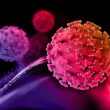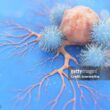Oncogenes and Tumor Suppressor Genes
The Dance Between Chaos and Order: The Impact of Tumour Suppressor Genes and Oncogenes on Cancer
Trillions of cells make up the intricate ecosystems that comprise our bodies, and each cell has a distinct purpose. The processes of cell division and growth are strictly regulated and are essential for health maintenance, repair, and development. Tumour suppressor genes and oncogenes are two major participants in this complex dance. Comprehending their respective roles is essential to understanding how cancer develops.
Table of Contents

Oncogenes: The Cell Division Gas Pedal
Oncogenes and Tumor Suppressor Genes
Proto-oncogenes, which are simply mutant forms of healthy genes, are the precursors of oncogenes. Similar to the gas pedal on an automobile, proto-oncogenes are essential for stimulating cell division and growth. They encode proteins that are involved in different cell-growth-promoting processes. Oncogenes can arise from mutations in these genes, including deletions, insertions, and duplications.
Oncogenes resulting from these mutations may become hyperactive, generating an overabundance of growth signals or becoming permanently “on,” even in the absence of growth signals. This throws off the regular cell cycle, which causes unchecked cell growth—a defining feature of cancer.
The following are some methods for activating oncogenes:
Oncogenes and Tumor Suppressor Genes
- Gain-of-function mutations: These mutations directly boost the oncogene-produced protein’s activity.
- Gene amplification: A cell produces more of the growth-promoting protein when it unintentionally obtains additional copies of an oncogene.
- Chromosome translocations: When segments of distinct chromosomes move into one another, an oncogene may be controlled by a separate regulatory element, which would result in its continuous activation.
Numerous malignancies have been linked to oncogenes. For instance, certain breast cancers are linked to the HER2 oncogene, while lung and colorectal cancers commonly harbour mutations in the RAS oncogene family.
Genes that Suppress Tumour Growth: The Stoppers
Oncogenes and Tumor Suppressor Genes
The brakes on cell division provided by tumour suppressor genes provide controlled growth and avoid unchecked proliferation. These genes produce the proteins that control apoptosis (programmed cell death), DNA repair, and the progression of the cell cycle.
Growth control may be lost if tumour suppressor gene mutations render them inactive. This may occur via a number of methods, such as:
- Mutations causing a loss of function: These mutations stop the tumour suppressor gene’s protein from operating as it should.
- Deletions: A tumour suppressor gene’s function may be totally lost if large portions of the chromosome carrying it are removed.
Oncogenes and Tumor Suppressor Genes
When tumour suppressor genes are weakened, cells either can’t react to signals that stop growth or die when they sustain harm. This fosters an atmosphere that is favourable to unchecked cell proliferation and the development of tumours.
p53, sometimes known as the “guardian of the genome,” and Rb, which controls the G1 phase of the cell cycle, are two well-known tumour suppressor genes. Many malignancies are known to have mutations in these genes.
A Two-Step Approach to Cancer: The Precarious Balance
Oncogenes and Tumor Suppressor Genes
Cancer is not the result of a single genetic mutation; rather, it is the result of a complex process that frequently involves the accumulation of mutations in several tumour suppressor and oncogene genes. The kind and severity of the cancer are determined by the particular mix of genetic changes.
Imagine driving a car that has a malfunctioning brake system (mutated tumour suppressor gene) and a malfunctioning gas pedal (mutated oncogene). Because of this combination, the car would probably accelerate uncontrollably, resembling the unregulated cell development that is characteristic of cancer.
A Glimmer of Hope: An Understanding of Oncogenes and Tumour Suppressor Genes
Oncogenes and Tumor Suppressor Genes
Our understanding of the formation of cancer has been completely transformed by research on tumour suppressor genes and oncogenes. The development of targeted medicines that aim to address the underlying genetic defects has been made possible by this knowledge.
For example, medications may be created to block the action of particular oncogenes or to enable tumour suppressor genes to operate again. Furthermore, alterations in these genes can be found via genetic testing, opening the door to more individualised treatment plans.
Oncogenes and Tumor Suppressor Genes
The complex interactions between tumour suppressor genes and oncogenes emphasise how crucial it is to keep cellular activities in a balanced state. By deciphering the mysteries of these genes, we might acquire important knowledge about the intricacies of cancer, providing hope for better detection, therapy, and eventually a cure for this terrible illness.


